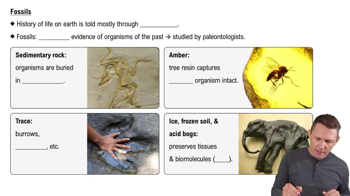Table of contents
- 1. Introduction to Biology2h 42m
- 2. Chemistry3h 40m
- 3. Water1h 26m
- 4. Biomolecules2h 23m
- 5. Cell Components2h 26m
- 6. The Membrane2h 31m
- 7. Energy and Metabolism2h 0m
- 8. Respiration2h 40m
- 9. Photosynthesis2h 49m
- 10. Cell Signaling59m
- 11. Cell Division2h 47m
- 12. Meiosis2h 0m
- 13. Mendelian Genetics4h 44m
- Introduction to Mendel's Experiments7m
- Genotype vs. Phenotype17m
- Punnett Squares13m
- Mendel's Experiments26m
- Mendel's Laws18m
- Monohybrid Crosses19m
- Test Crosses14m
- Dihybrid Crosses20m
- Punnett Square Probability26m
- Incomplete Dominance vs. Codominance20m
- Epistasis7m
- Non-Mendelian Genetics12m
- Pedigrees6m
- Autosomal Inheritance21m
- Sex-Linked Inheritance43m
- X-Inactivation9m
- 14. DNA Synthesis2h 27m
- 15. Gene Expression3h 20m
- 16. Regulation of Expression3h 31m
- Introduction to Regulation of Gene Expression13m
- Prokaryotic Gene Regulation via Operons27m
- The Lac Operon21m
- Glucose's Impact on Lac Operon25m
- The Trp Operon20m
- Review of the Lac Operon & Trp Operon11m
- Introduction to Eukaryotic Gene Regulation9m
- Eukaryotic Chromatin Modifications16m
- Eukaryotic Transcriptional Control22m
- Eukaryotic Post-Transcriptional Regulation28m
- Eukaryotic Post-Translational Regulation13m
- 17. Viruses37m
- 18. Biotechnology2h 58m
- 19. Genomics17m
- 20. Development1h 5m
- 21. Evolution3h 1m
- 22. Evolution of Populations3h 53m
- 23. Speciation1h 37m
- 24. History of Life on Earth2h 6m
- 25. Phylogeny2h 31m
- 26. Prokaryotes4h 59m
- 27. Protists1h 12m
- 28. Plants1h 22m
- 29. Fungi36m
- 30. Overview of Animals34m
- 31. Invertebrates1h 2m
- 32. Vertebrates50m
- 33. Plant Anatomy1h 3m
- 34. Vascular Plant Transport1h 2m
- 35. Soil37m
- 36. Plant Reproduction47m
- 37. Plant Sensation and Response1h 9m
- 38. Animal Form and Function1h 19m
- 39. Digestive System1h 10m
- 40. Circulatory System1h 49m
- 41. Immune System1h 12m
- 42. Osmoregulation and Excretion50m
- 43. Endocrine System1h 4m
- 44. Animal Reproduction1h 2m
- 45. Nervous System1h 55m
- 46. Sensory Systems46m
- 47. Muscle Systems23m
- 48. Ecology3h 11m
- Introduction to Ecology20m
- Biogeography14m
- Earth's Climate Patterns50m
- Introduction to Terrestrial Biomes10m
- Terrestrial Biomes: Near Equator13m
- Terrestrial Biomes: Temperate Regions10m
- Terrestrial Biomes: Northern Regions15m
- Introduction to Aquatic Biomes27m
- Freshwater Aquatic Biomes14m
- Marine Aquatic Biomes13m
- 49. Animal Behavior28m
- 50. Population Ecology3h 41m
- Introduction to Population Ecology28m
- Population Sampling Methods23m
- Life History12m
- Population Demography17m
- Factors Limiting Population Growth14m
- Introduction to Population Growth Models22m
- Linear Population Growth6m
- Exponential Population Growth29m
- Logistic Population Growth32m
- r/K Selection10m
- The Human Population22m
- 51. Community Ecology2h 46m
- Introduction to Community Ecology2m
- Introduction to Community Interactions9m
- Community Interactions: Competition (-/-)38m
- Community Interactions: Exploitation (+/-)23m
- Community Interactions: Mutualism (+/+) & Commensalism (+/0)9m
- Community Structure35m
- Community Dynamics26m
- Geographic Impact on Communities21m
- 52. Ecosystems2h 36m
- 53. Conservation Biology24m
24. History of Life on Earth
History of Life on Earth
Problem 1
Textbook Question
Choose the best definition of a fossil.
a. A rock that contains information about an organism
b. A bone, tooth, shell, or other hard part of an organism that has been preserved
c. Any trace of an organism that lived in the past
d. Any part of a dead organism
 Verified step by step guidance
Verified step by step guidance1
Understand the concept of a fossil: Fossils are the preserved remains or traces of organisms that lived in the past. They provide valuable information about the history of life on Earth.
Consider the types of fossils: Fossils can be actual remains like bones, teeth, or shells, or they can be traces such as footprints, burrows, or imprints.
Evaluate the options: Option a suggests a rock containing information, which is not specific to fossils. Option b focuses on hard parts, which are common but not exclusive to fossils. Option c encompasses any trace, which is a broader and more inclusive definition. Option d refers to any part of a dead organism, which is too general.
Identify the most comprehensive definition: A fossil is not limited to hard parts or any part of a dead organism; it includes traces and remains that provide evidence of past life.
Select the best definition: Based on the understanding that fossils include both remains and traces, option c, 'any trace of an organism that lived in the past,' is the most accurate and comprehensive definition.
 Verified video answer for a similar problem:
Verified video answer for a similar problem:This video solution was recommended by our tutors as helpful for the problem above
Video duration:
34sPlay a video:
Was this helpful?
Key Concepts
Here are the essential concepts you must grasp in order to answer the question correctly.
Fossil Definition
A fossil is any preserved evidence of an organism that lived in the past. This can include not only the hard parts like bones and shells but also traces such as footprints, burrows, or even chemical markers. The key aspect is that fossils provide information about past life forms and their environments.
Recommended video:

Fossils
Preservation of Organisms
Preservation refers to the process by which remains or traces of organisms are protected from decay and remain intact over geological time. This can occur through various means, such as mineralization, where organic material is replaced by minerals, or through natural encasement in substances like amber or ice.
Recommended video:
Guided course

Organization of DNA in the Cell
Trace Fossils
Trace fossils, also known as ichnofossils, are geological records of biological activity. They include footprints, burrows, and other indirect signs of an organism's presence, rather than the organism itself. These traces provide valuable insights into the behavior and movement of ancient life forms.
Recommended video:

Fossils
Related Videos
Related Practice
Multiple Choice
Which of the following occurred during the Mesozoic era?
1556
views


